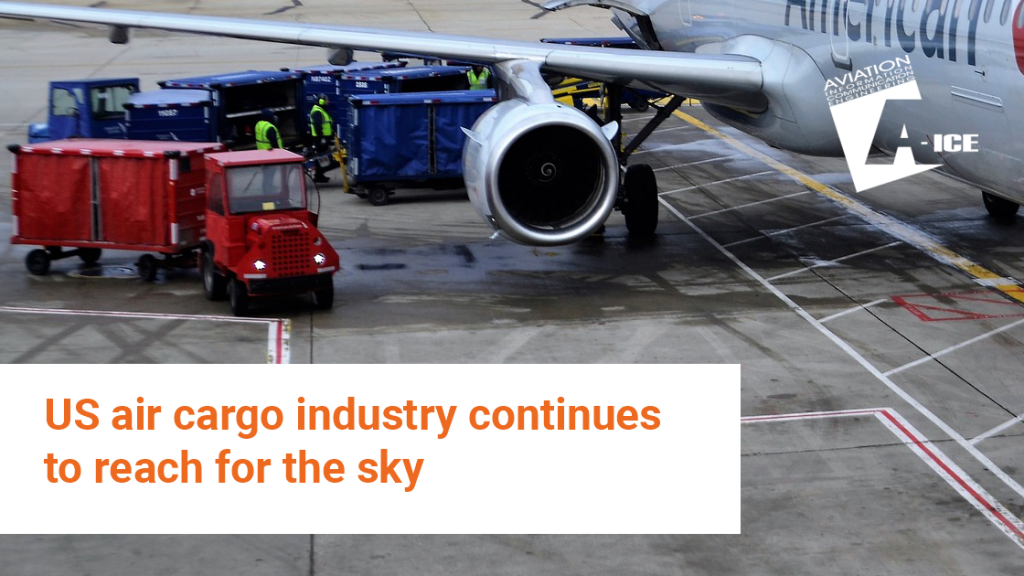US air cargo industry continues to reach for the sky
| Company | A-ICE |
|---|---|
| Date | 29.07.2021 |

As the international aviation community work towards a responsible and more importantly, sustainable recovery from the effects of the COVID-19 pandemic, there is continuing record growth across the air cargo sector.
In the US, potential significant government investment looks to encourage expansion, more airlines are adding more freight routes and new initiatives in biometrics will provide a much-needed positive boost for industry professionals. We take a closer look at some of the best news to come out of the US air cargo industry during this first quarter of the recovery period.
Air cargo outperforms pre-pandemic levels
Since March 2021, IATA has released global air cargo market data that shows the sector outperforming pre-COVID-19 levels. During March this year, air cargo demand was at its highest since 1990 and April 2021 showed a 12% increase on April 2019’s figures.
It is worth noting that IATA has set ‘pre-pandemic’ as April 2019, due to the distortion of figures during 2020 under the impact of COVID-19.
“Air cargo continues to be the good news story for the air transport sector. Demand is up by 12 per cent on pre-crisis levels and yields are solid. Some regions are outperforming the global trend, most notably carriers in North America, the Middle East and Africa. Strong air cargo performance, however, is not universal. The recovery for carriers in the Latin American region, for example, is stalled.” said Willie Walsh, IATA’s Director General.
North America’s carriers lead the way in strength of performance, according to IATA, but most other regions are also supporting growth. Latin America appears to be the only region where growth contribution has stalled. There are, however, still global capacity issues, which are beginning to be addressed across the US.
Philadelphia Airport cargo facility expansion plan could create 28,000 jobs
Already, Philadelphia Airport (PHL) has plans in the pipeline to expand its air cargo facilities. In a project that could create 28,000 jobs, PHL is aiming for a 136-acre expansion which will increase the cargo facility from 600,000 to 1.4 million sq. ft.
Approval has also been granted for over 5 million sq. ft. of additional taxiway and apron to accommodate the extra capacity it will need.
Amazon Air cargo facility at sixth-largest cargo airport CVG
Amazon Air, established just five years ago, announced earlier this year its plans to complete a new facility at Cincinnati/North Kentucky Airport (CVG). The facility, scheduled to be ready for use later this year will house a 798,000 sq. ft. sorting centre, a multi-level parking zone and room to park and manoeuvre 20 Amazon Air aircraft.
The mile-long air cargo facility is to be the home of the Amazon Air national air transport network, which operates hundreds of daily flights to 35 US cities.
Online shopping increases contribute significantly to global cargo demand
With the unprecedented increase of online shopping on a global scale during the health crisis, air cargo demand has been higher than ever. Industry analysts and eCommerce professionals believe that many of these trends may be here to stay, as consumers ‘fall out of the habit’ of going out to shops and the high street.
While initial focus at the beginning of 2020 was firmly on the delivery of essential PPE, pharma and hygiene products, demand has increased dramatically for other items. Shipping lines are still in consistent high demand too, but air cargo transportation is taking off in terms of timescale, where faster delivery is becoming a higher priority for businesses and consumers.
Smart airport solutions streamline air cargo and ground handling
There is growing interest and a higher uptake in smart airport solutions (https://a-ice.aero/aic-airport-in-cloud/) since the start of the pandemic. According to many industry professionals, this has been heavily influenced by social distancing and reduced staffing levels on the ground.
Smart and biometric solutions to manage passengers and cargo have been gaining traction in recent pre-pandemic years due to the accelerating demand of the time. The ability to streamline routine processes and meet compliance has long been a priority in tasks such as:
- Baggage handling and tracking
- Cargo handling, tracking and weight and balance
- Security (passenger and facility)
- Passenger processing
Today, these technologies are smoothing and accelerating freight and ground handling operations for teams of all sizes. They are enabling faster turnaround, which is in turn reducing operational costs and facilitating a wider change across the industry.
With significant investments on the horizon for US airports infrastructure, major expansion plans and no sign of air cargo demand slowing, there has never been a better time for the air freight sector to harness the opportunities. Smart airport technologies can deliver the changes needed to future proof facilities and facilitate a better way of operating.
Contact
00071, Pomezia (Rome) ITALY
-
Branches
Milan: Viale Enrico Forlanini 23, 20134
Milano, ITALY
-
USA: 1140 3rd Street, N.E., Washington
District of Columbia, 20002, USA
-
London: 17 Carlisle Street, 1st Floor, London
England, W1D 3BU, UNITED KINGDOM
-
- Rome (HQ): +39 0690214421

